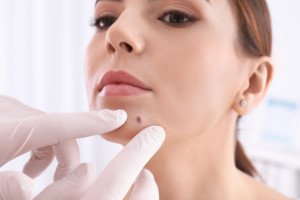
If a teen’s mole is suspicious enough for a doctor to say, “It should be watched,” then why not just biopsy it in case it’s melanoma?
Teens DO get melanoma.
“Melanoma among adolescents and young adults (aged 15-39 years) is more commonly seen in females compared to males, with the majority seen on the trunk,” says Nita Patel, MD, Medical Director of Advance Dermatology and Laser Medical Center in Marina Del Rey, CA.
Teen’s “Watched” Mole Turns out to Be Melanoma Two Years Later
I was inspired to write this article after reading in an online health forum about a boy, 15, who had a new “mole” on his head examined by a dermatologist.
None of it was removed for biopsy even though the doctor told him and his parents to keep an eye on it.
Two years later it seemed a little bigger, and this time it was removed for biopsy. The diagnosis was melanoma that had spread to the lymph nodes.
He underwent chemo and radiation, but five years later, he died from metastatic melanoma.
I wondered why the mole, which was suspicious enough for the doctor to tell the teen and his parents to keep an eye on it, wasn’t simply biopsied right from the get-go.
The earlier that melanoma is diagnosed, the higher the chance of long-term survival. In fact, the 10-year survival rate for stage 0 (in situ) melanoma is 99 percent.
“The decision to biopsy is typically a clinical judgement,” says Dr. Patel. However, if the parents want a mole biopsied, a doctor will very likely honor this request.
Depending on the doctor’s philosophy, a mole will be biopsied simply if the patient feels uneasy about it.
Of course, there are limits to this, in that a doctor isn’t going to remove every single mole just because the patient is fearful of melanoma. But within reason, a biopsy request is usually granted.
“If a mole has a slight irregularity, close monitoring is helpful to decide if a mole should be biopsied,” says Dr. Patel.
“Re-evaluating a mole in a 1-2 month period for changes can help determine if a biopsy is indicated.
“An alternative approach is the use of a new adhesive patch biopsy kit that tests for gene sequences that are seen with melanoma.
“This is a noninvasive method of collecting additional information especially in pediatric populations which may not be able to undergo an invasive biopsy.”
Suspicious Mole on Teen: Watch It or Biopsy It?
“Typically if the mole shows some signs of irregularity, I discuss the option of close monitoring, evaluation excision with a punch biopsy or adhesive biopsy and pigment lesion assay (PLA),” says Dr. Patel.
“The PLA uses advanced genetics to identify two genes, LINC and PRAME, which are elevated in melanoma skin cancer.”
DermTech’s PLA can differentiate melanoma from a benign mole or other lesion with a negative predictive value (meaning no disease) of over 99 percent.
This tool yields a sensitivity of 91 percent and a specificity of 69 percent – without the need for invasive biopsy.
A biopsy of a mole is not as invasive as a teen or parents might think. Hearing the word “biopsy” can unsettle a patient, but the actual procedure is not as penetrating as it sounds.
The needle for the local anesthetic usually causes less pain than a typical paper cut or razor nick.
Nevertheless, a patient may want to forego a biopsy (which, depending on the type of procedure and the size of the mole, will require stitches).
If a doctor wants your teenager’s mole to be “watched” or to “keep an eye on it,” the PLA will offer the advantage of patient comfort plus convenience, especially if there is more than one suspicious mole or a mole is in a cosmetically sensitive area.
“If the parents choose to pursue a biopsy, an excisional biopsy is performed to obtain a complete visualization of the mole on pathologic exam,” says Dr. Patel.
“I send the slide to a dermatopathologist for microscopic examination.”
 Dr. Patel is a Diplomate of the American Board of Dermatology and has extensive experience in general dermatology, skin cancer surgery, cosmetic procedures and lasers.
Dr. Patel is a Diplomate of the American Board of Dermatology and has extensive experience in general dermatology, skin cancer surgery, cosmetic procedures and lasers.
 Lorra Garrick has been covering medical, fitness and cybersecurity topics for many years, having written thousands of articles for print magazines and websites, including as a ghostwriter. She’s also a former ACE-certified personal trainer.
Lorra Garrick has been covering medical, fitness and cybersecurity topics for many years, having written thousands of articles for print magazines and websites, including as a ghostwriter. She’s also a former ACE-certified personal trainer.
.
























